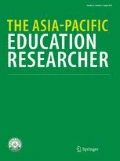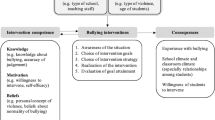Abstract
The purpose of this study was to investigate whether teachers’ ability to identify bullying incidents could be enhanced by offering bullying identification trainings. The participants of this study were 532 primary, middle, and high school teachers in Taiwan, who were recruited to participate in one of the four study groups (three treatment groups and one control group). Those in the three treatment groups were provided with the following interventions: a 1.5-h training on bullying identification (Group X); a definition including the features of bullying in written form (Group Y); and a written definition accompanied by checklist of three bullying characteristics for each scenario (Group Z). A 24-item Recognition of Bullying Incidents Questionnaire (RBIQ) was used in this study. Of these 24 scenarios, 12 were used to assess participants in the pre-test phase, and 12 were used for the post-test. The results, using a mixed-model two-way analysis of variance, indicated that the teachers in Group X were significantly better at bullying identification than those in other groups. Teachers in Group Z also were significantly better at bullying identification than teachers in Group Y and the control group. These results imply that merely providing a definition does little to enhance teachers’ ability to identify school bullying.


Similar content being viewed by others
References
Bauman, S., & Del Rio, A. (2005). Knowledge and beliefs about bullying in schools comparing pre-service teachers in the United States and the United Kingdom. School Psychology International, 26, 428–442. doi:10.1177/0143034305059019.
Bauman, S., & Del Rio, A. (2006). Preservice teachers’ responses to bullying scenarios: Comparing physical, verbal, and relational bullying. Journal of Educational Psychology, 98, 219–231. doi:10.1037/0022-0663.98.1.219.
Bennett, D. A. (2001). How can I deal with missing data in my study? Australian and New Zealand Journal of Public Health, 25, 464–469. doi:10.1111/j.1467-842X.2001.tb00294.x.
Berger, K. S. (2007). Update on bullying at school: Science forgotten? Developmental Review, 27, 90–126. doi:10.1016/j.dr.2006.08.002.
Bond, T., & Fox, C. (2007). Applying the Rasch model: Fundamental measurement in the human sciences (2nd ed.). Mahwah, NJ: Lawrence Erlbaum Associates.
Burger, C., Strohmeier, D., Spröber, N., Bauman, S., & Rigby, K. (2015). How teachers respond to school bullying: An examination of self-reported intervention strategy use, moderator effects, and concurrent use of multiple strategies. Teaching and Teacher Education, 51, 191–202. doi:10.1016/j.tate.2015.07.004.
Byers, D. L., Caltabiano, N. J., & Caltabiano, M. L. (2011). Teachers’ attitudes towards overt and covert bullying, and perceived efficacy to intervene. Australian Journal of Teacher Education, 36, 105–119. doi:10.14221/ajte.2011v36n11.1.
Carney, J. V. (2005). Factor structure of the bullying situations identification (BSI) instrument. Journal of School Violence, 4, 77–92. doi:10.1300/J202v04n03_07.
Charmaraman, L., Jones, A. E., Stein, E., & Espelage, D. L. (2013). Is it bullying or sexual harassment? Knowledge, attitudes, and professional development experiences of middle school. Journal of School Health, 83, 438–444. doi:10.1111/josh.12048.
Cheng, Y. Y., Chen, L. M., Ho, H. C., & Cheng, C. L. (2011). Definitions of school bullying in Taiwan: A comparison of multiple perspectives. School Psychology International, 32, 227–243. doi:10.1177/0143034311404130.
Chiu, J., & Chang, L. L. (2012). Identification, evaluation, and intervention of bullying behaviors in secondary and elementary school teachers. Research in Applied Psychology, 54, 203–250.
Cohen, J. (1988). Statistical power analysis for the behavioral sciences (2nd ed.). Hillsdale, NJ: Lawrence Earlbaum Associates.
Craig, K., Bell, D., & Leschied, A. (2011). Pre-service teachers’ knowledge and attitudes regarding school-based bullying. Canadian Journal of Education, 34, 21–33.
Dedousis-Wallacea, A., Shuteb, S., Varlowa, M., Murrihya, R., & Kidmana, T. (2014). Predictors of teacher intervention in indirect bullying at school and outcome of a professional development presentation for teachers. Educational Psychology, 34, 862–875. doi:10.1080/01443410.2013.785385.
Gordillo, I. C. (2011). Divergence in aggressors’ and victims’ perceptions of bullying: A decisive factor for differential psychosocial intervention. Children and Youth Services Review, 33, 1608–1615. doi:10.1016/j.childyouth.2011.04.002.
Hazler, R., Miller, D., Carney, J., & Green, S. (2001). Adult recognition of school bullying situations. Educational Research, 43, 133–146. doi:10.1080/00131880110051137.
Latané, B., & Darley, J. M. (1970). The unresponsive bystander: Why doesn’t he help?. New York: Appleton-Century Crofts.
Linacre, J. M. (2006). A user’s guide to WINSTEPS Rasch model computer program. Chicago, IL: Winsteps.
Menesini, E., Fonzi, A., & Smith, P. K. (2002). Attribution of meanings to terms related to bullying: A comparison between teacher’s and pupil’s perspectives in Italy. European Journal of Psychology of Education, 17, 393–406. doi:10.1007/BF03173593.
Migliaccio, T. (2015). Teacher engagement with bullying: Managing an identity within a school. Sociological Spectrum, 35, 84–108. doi:10.1080/02732173.2014.978430.
Mishna, F., Pepler, D., & Wiener, J. (2006). Factors associated with perceptions and responses to bullying situations by children, parents, teachers, and principals. Victims and Offenders, 1, 255–288. doi:10.1080/15564880600626163.
Mishna, F., Scarcello, I., Pepler, D., & Wiener, J. (2005). Teacher’s understanding of bullying. Canadian Journal of Education, 28, 718–738. doi:10.2307/4126452.
Naylor, A., Cowie, H., Cossin, F., Bettencourt, R. D., & Lemme, F. (2006). Teachers’ and pupils’ definitions of bullying. British Journal of Educational Psychology, 76, 553–576. doi:10.1348/000709905X52229.
Oldenburg, R., Bosman, R., & Veenstra, R. (2015a). Are elementary school teachers prepared to tackle bullying? A pilot study. School Psychology International, 37, 64–72. doi:10.1177/0143034315623324.
Oldenburg, B., van Duijn, M., Sentse, M., Huitsing, G., van der Ploeg, R., Salmivalli, C., et al. (2015b). Teacher characteristics and peer victimization in elementary schools: A classroom-level perspective. Journal of Abnormal Child Psychology, 43, 33–44. doi:10.1007/s10802-013-9847-4.
Olweus, D. (1993). Bullying at school: What we know and what we can do. Cambridge, MA: Blackwell Publishers.
Rivers, I., & Smith, P. K. (1994). Types of bullying behaviour and their correlates. Aggressive Behavior, 20, 359–368. doi:10.1002/1098-2337.
Schafer, J. L. (1999). Multiple imputation: A primer. Statistical Methods in Medical Research, 8, 3–15. doi:10.1177/096228029900800102.
Smith, H., Varjas, K., Meyers, J., Marshall, M. L., Ruffner, C., & Graybill, E. C. (2009). Teachers’ perceptions of teasing in schools. Journal of School Violence, 9, 2–22. doi:10.1080/15388220903185522.
Vaillancourt, T., McDougall, P., Krygsman, A., Hymel, S., Miller, J., Stiver, K., et al. (2008). Bullying: Are researchers and children/youth talking about the same thing? International Journal of Behavioral Development, 32, 486–495. doi:10.1177/0165025408095553.
Wright, B. D., & Linacre, J. M. (1994). Chi square fit statistics. Rasch Measurement Transactions, 8, 370.
Wu, M., & Adams, R. (2007). Applying the Rasch model to psycho-social measurement: A practical approach. Melbourne: Educational Measurement Solutions.
Funding
This research received no grant from any funding agency in the public, commercial or not-for-profit sectors.
Author information
Authors and Affiliations
Corresponding author
Ethics declarations
Conflict of interest
The authors declared no conflicts of interest with respect to the authorship and/or publication of this article.
Rights and permissions
About this article
Cite this article
Chen, LM., Sung, YH. & Cheng, W. How to Enhance Teachers’ Bullying Identification: A Comparison Among Providing a Training Program, a Written Definition, and a Definition with a Checklist of Bullying Characteristics. Asia-Pacific Edu Res 26, 351–359 (2017). https://doi.org/10.1007/s40299-017-0354-1
Published:
Issue Date:
DOI: https://doi.org/10.1007/s40299-017-0354-1




